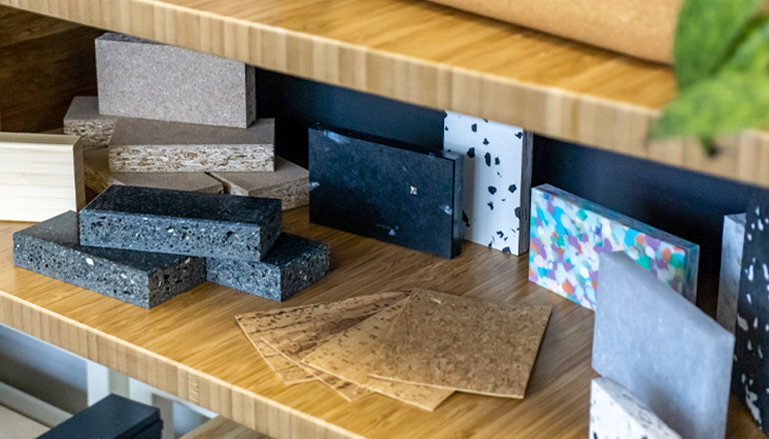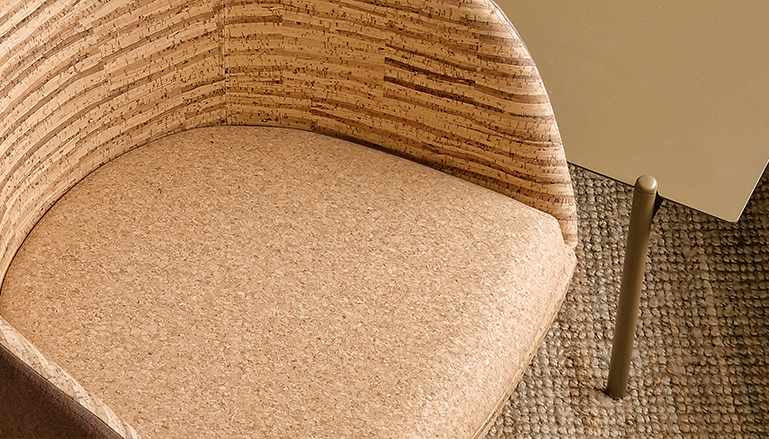Sustainable Material Spotlight
Inspiration
This month the UK has experienced the coldest night of 2023 and the coldest March night in 13 years. As a stark contrast to 2022s sunniest March since 1929, our erratic weather is a blatant reminder of the ongoing climate crisis. It’s more vital than ever that we’re all playing a part in reducing our carbon footprints and pushing the boundaries of sustainable design.
On the back of The Paris Agreement and the COP26 2030 emissions reduction targets, more and more interiors need to meet strict sustainability goals. One effective way to reduce an interior’s carbon footprint is to be selective of the most sustainability-accredited materials.
Sustainability doesn’t have to mean compromising on design and aesthetics, either. Here we’ve rounded up some of our favourite beautiful and eco-friendly materials.

Recycled Plastic
Plastics are the classic “bad guy” of the materials world. Convenient, cost-effective to produce, and designed to be durable and long-lasting. At face value, this sounds fantastic. But when linked to modern throwaway culture, we have a recipe for one of the most pressing environmental issues on the planet – plastic pollution. Responsible for the deaths of millions of animals every year.
So goodbye to virgin plastics and hello to recycled plastic! The good news is that this leftover, durable waste can be recycled repeatedly into new material. Not only does manufacturing new products from recycled plastic help prevent pollution, but it’s also a much more sustainable process. Producing a plastic bottle from recycled PET uses 75% less energy than virgin plastic.
More and more innovative and exciting recycled plastic materials are becoming available. Vast ranges of colours, finishes and designs celebrate the significant environmental story of the material. Our Reece sofa range is the perfect way to showcase this in your space. Recycled plastic frames and tabletops champion Reece’s sustainability story, a story which extends much further than just the materials involved.

Cork
Many of us are familiar with cork as an interior design staple of the 1970s that perhaps should remain there, though as we see so often with design trends, another comeback is in full swing. But don’t be disheartened by its dated reputation. These days cork has so much more to offer than overtly orange, varnished floor tiles.
The realisation of cork’s unrivalled sustainability properties, combined with innovative technology developments offering new application possibilities, is partly to thank for the recent surge in cork popularity. Perhaps also boosted by society’s rose-tinted views surrounding nostalgia trends.
This durable, 100% natural raw material is carbon negative and completely renewable. Cork sheets can be harvested from the cork oak tree around 15 times during the tree’s 200-year lifespan. The harvesting process causes no damage to the tree and even prolongs its life, encouraging more carbon absorption with every regeneration of the cork layer.
From an interior design perspective, cork is appearing in increasingly surprising applications. The natural acoustic and thermal properties make cork ideal for wall coverings, whilst its mouldable structure makes it perfect for shaping into solid furniture and decor.
Most recently, there’s been a rise in cork-based fabrics as natural alternatives to leather or vinyl, so even upholstered products are taking on this growing trend. Try specifying a cork fabric on some of our Pop or Hex stools for a playful, sustainable seating area.

Bamboo
Cork isn’t the only 1970s throwback making a resurgence. The heightened societal awareness of sustainability is driving a desire for many other natural materials, which we generally associate with vintage, like rattan, bamboo and wicker. Though bamboo materials today are a far cry from the rustic cane seating of the past, new technology is driving innovation in polished surface materials and versatile, durable hardwood alternatives.
The most eco-friendly wood alternative on the planet, bamboo is stronger and more durable than traditional hardwoods and is the fastest-growing plant on earth. Depending on the variety, bamboo plants reach maturity as quickly as five years, significantly faster than any tree species. Not only that, but bamboo groves don’t need replanting like forests. Bamboo naturally regenerates as harvesting the plant encourages new growth from the subterranean root system.
Bamboo groves are crucial to balancing the CO2 and oxygen in our atmosphere, making bamboo products the perfect wood alternative for a low CO2 interior. The incredible growth rate allows bamboo to release 35% more oxygen into the atmosphere than a hardwood forest. Also harnessing unrivalled carbon-storing properties, bamboo is able to sequester up to 1.78 tonnes of CO2 per bamboo clump per year, translating into a CO2 drawdown curve 10X faster than that of woody trees.
The versatility of this super-material is apparent across our product portfolio. Choose bamboo as a practical, natural tabletop surface for our Milo and Icarus table ranges, or make a visual statement as a decorative finish option for Bodyn, Calvert or Reece.

